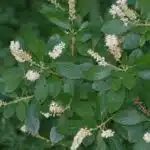The Purple Leaf Sand Cherry, a plant that has been the envy of gardeners for centuries. Not only does it look beautiful in any garden, but it also offers an array of health benefits to those who care for it. Unfortunately, many people are unaware of how to properly grow and care for this unique plant. Luckily, this article aims to provide you with all the information necessary so that you can finally make your gardening dreams come true!
At first glance, the Purple Leaf Sand Cherry appears to be a simple shrub that requires minimal care. However, it is actually quite demanding when it comes to its growth and maintenance needs. Its delicate purple leaves require specific soil composition and frequent pruning in order to remain healthy and vibrant. In addition, its delicate flowers require careful attention in order to produce the desired result of deep purple petals. As such, it is important to understand exactly what is required when growing and caring for this unique plant if one hopes to have success with growing them in their own garden or backyard.
In this comprehensive guide written by a specialist in botany and gardening, readers will learn exactly what they need to do in order to successfully grow and care for their Purple Leaf Sand Cherry plants. From proper soil composition and frequent pruning techniques, all the way through to tips on how best to protect these plants from disease and pests, everything one needs will be laid out in detailed step-by-step instructions that even novice gardeners can follow with confidence. So if you have been dreaming of having your own Purple Leaf Sand Cherry bush or tree at home then read on – you’re about to learn everything there is know about growing these beautiful plants!
Overview Of Purple Leaf Sand Cherry
The Purple Leaf Sand Cherry (Prunus x cistena) is a deciduous shrub hailing from the rose family. It is also known as the Purpleleafed Sandcherry and exhibits a distinctive purple foliage that makes it stand out amongst other plants. This hardy shrub is native to North America and can be found in many gardens, parks, and public spaces. Its flowers are small but abundant, with white petals that contrast nicely against its deep purple foliage. Its edible fruits are also quite tasty and can be used for a variety of recipes.
When it comes to growing this beautiful shrub, there are a few key factors to consider. For example, this plant prefers moist soil conditions and needs full-sun exposure to achieve optimal growth. It can thrive in most climates but has some specific requirements when grown in colder regions. Additionally, it requires regular pruning to maintain its shape and size, although it responds well to light pruning throughout the season.
Overall, the Purple Leaf Sand Cherry is an easy-to-care-for shrub that offers year-round beauty. With proper care and attention, this plant can provide many years of enjoyment with minimal effort from its gardener. As such, it should be an ideal choice for any gardener looking for a low maintenance yet vibrant addition to their outdoor space. Now that you know more about this stunning shrub, let’s explore how to select the best location for optimal growth results.
Choosing The Right Location
Choosing the right location for your purple leaf sand cherry is crucial for its long-term success. Planting in an appropriate spot will ensure that your shrub will flourish and provide a burst of color to your garden or landscape. As with all shrubs, think carefully before you plant and take into consideration the site’s sun exposure and soil type.
The purple leaf sand cherry thrives in full sun, so pick a spot where the shrub can soak up plenty of direct sunlight. It can tolerate some shade but won’t reach its full potential if it’s not bathed in sunshine most of the day. The part-sun/part-shade locations will be sufficient as well.
Next, pay attention to soil type – this variety prefers sandy loam that drains quickly. Avoid wet areas or sites with heavy clay soil because the sand cherry won’t be happy there and may struggle with root rot or other problems down the line. If you have heavy clay soils, consider amending with organic matter like compost to improve drainage and aeration. Now that you’ve selected a sunny spot with well-draining soil, it’s time to get planting!
Planting Instructions
Planting a purple leaf sand cherry is an exciting process, especially when you consider the beauty it will add to your garden. Before embarking on this journey, however, it’s important to have a clear idea of what you need to do in terms of planting. With the right approach and some knowledge, you can ensure that your purple leaf sand cherry flourishes in its new home.
The first step in planting your purple leaf sand cherry is to choose the right site. The best spot for this shrub is one that gets full sun and has moist, well-drained soil. It should also be sheltered from strong winds and any other extreme weather conditions. You may want to use a soil test to check whether or not the pH levels are suitable for the plant – they should be between 6.0 and 7.5 for optimal growth.
Once you’ve found the perfect location for your shrub, it’s time to start planting! Dig a hole twice as wide as the root ball of your purple leaf sand cherry and just slightly deeper than its container. Place the shrub into the hole, making sure that it’s firmly rooted and evenly spaced within the hole before backfilling with soil. Water generously after planting – this will help keep your plant hydrated during its first few weeks in its new environment.
To give your purple leaf sand cherry enough nutrients for healthy growth, fertilize twice a year: once in early spring and again in late summer or early fall. This will ensure that all necessary minerals are available for robust root development throughout its life cycle. With proper care, your shrub can thrive and remain beautiful for many years to come!
Sunlight Requirements
The sunlight requirements for a purple leaf sand cherry are like a ray of sunshine: warm, illuminating, and essential. They need plenty of bright light to reach their full potential, and without it, their growth will be stunted. As a Specialist in botany and gardening, I recommend they get at least 6 hours of direct sunlight each day. This can be achieved by strategically planting them in a location that gets plenty of sun throughout the day or providing supplemental lighting with artificial bulbs.
When it comes to the shade-tolerance of a purple leaf sand cherry, it’s important to remember that they do not thrive in low-light environments. In fact, if they receive too little light, their foliage may become sparse and yellowed. So if you have an area where your plant will only get partial shade instead of full sun, make sure you supplement the light accordingly.
With the right care and attention, including providing ample sunlight for your purple leaf sand cherry plants, you’ll be rewarded with strong growth and beautiful blooms. Now let’s move onto discussing water needs so your potted plants can flourish!
Water Needs
Water is like a life-giving elixir to all plants, and Purple Leaf Sand Cherry is no exception. It needs a regular supply of water to thrive, similar to the way people need water for sustenance. To ensure this, here are some tips and considerations:
• Ensure that the soil around the plant remains moist at all times. • Water in the morning or evening when temperatures are cooler and less evaporation occurs. • If rainfall is inadequate or sporadic, use a soaker hose or drip irrigation system to provide consistent moisture. • During periods of extreme heat, water more frequently but in smaller quantities.
This shrub does not tolerate flooding or soggy conditions at roots; such conditions can cause root rot and other diseases. Therefore, it’s important to check soil moisture regularly and adjust watering frequency as necessary. With proper care and attention to its needs, Purple Leaf Sand Cherry will reward gardeners with its vibrant foliage throughout the growing season.
Soil Considerations
Soil considerations are a key part of successfully growing and caring for purple leaf sand cherry. As an example, consider the case of a homeowner in Chicago who wants to add this plant to their garden. They need to make sure they provide proper soil conditions or the plant won’t thrive. Here are a few important points to remember:
First, the soil should be well-draining, with a pH between 5.5 and 6.8. If it’s too alkaline or if there is any standing water after watering, the roots could rot and cause serious damage to the plant. Second, adding organic matter such as compost will help retain moisture in the soil while also providing nutrition for the plant. Finally, mulching around the base can help reduce weeds and keep moisture levels consistent throughout the season.
When considering soil for purple leaf sand cherry, it’s important that both drainage and fertility needs are addressed properly. The best way to ensure this is by adding organic matter like compost or aged manure as well as mulching around the base of the plant. With these measures taken, you’ll have created an ideal home for your purple leaf sand cherry that helps it grow and flourish!
Fertilizer Needs
The fertilizer needs of the Purple Leaf Sand Cherry are truly staggering! With the right amount of effort and care, these beautiful plants can reach heights that seem to soar into the sky. As experienced gardeners know, however, achieving this level of growth requires a significant investment.
Specifically, Purple Leaf Sand Cherries need access to certain nutrients in order to thrive. This is why fertilizing your plant is an essential part of caring for it. The type and amount of fertilizer you use will depend on the type of soil you have planted your shrub in, as well as its age and size.
To get the most out of your shrub’s growth cycle, it’s important to use a balanced fertilizer that is specifically made for acid-loving plants like the Purple Leaf Sand Cherry. If applied correctly, this will provide your shrub with all the necessary nutrients that it needs for optimal development. Doing so will ensure that your plant grows healthy, vibrant foliage for years to come!
With ample nutrition and proper pruning techniques, you’ll be able to create a stunning hedge or landscaping feature that can bring beauty and charm to any outdoor space.
Pruning Tips
Pruning is an important step for maintaining the attractive shape and size of the Purple Leaf Sand Cherry. This shrub can grow up to 6 feet tall and 8 feet wide, so it’s important to trim it regularly to keep it within the desired size and shape. On average, this species should be pruned twice a year – once in late winter and again in mid-summer. Here are some tips for successful pruning:
First, remove any dead or damaged branches with sharp shears or a saw. Make sure your tools are clean before use – this will help prevent disease spread. Next, thin out any overcrowded branches by cutting back to an outward-facing bud. This will help promote air circulation around the plant and encourage new growth. Also, cut away any shoots growing too close to the ground as they can harbor pests or disease. Finally, if you’re wanting to create a denser canopy of foliage, selectively prune side shoots along the stems during mid-summer months.
It’s important to remember that healthy pruning will not only improve the aesthetic appearance of your Purple Leaf Sand Cherry but also its overall health and vigor. By removing dead or damaged branches, thinning out crowded areas, cutting away low-lying shoots, and selectively pruning side shoots when needed – you’ll be well on your way towards creating a beautiful landscape feature! Now that we have discussed proper pruning techniques for this species of shrub, let’s take a look at potential pest and disease problems associated with it.
Pest And Disease Problems
The Purple Leaf Sand Cherry’s lush, deep-colored foliage is a sight to behold. Its purple leaves shimmer and shimmer, inviting wildlife and gardeners alike to admire its beauty. But despite its charm, this delightful shrub has some pests and diseases that can wreak havoc on your garden if not managed properly. As a specialist in botany and gardening, let me take you through the essential steps for keeping this bush healthy and happy.
Pests such as aphids, spider mites, borers, and scale insects can all be found on Purple Leaf Sand Cherrys. Fortunately, these pests can be controlled with regular applications of insecticidal soap, neem oil, or horticultural oil. Keep in mind that these products will need to be reapplied every few weeks throughout the growing season to ensure their effectiveness.
When it comes to diseases, there are several fungal infections that can occur on Purple Leaf Sand Cherrys including leaf spot and powdery mildew. To prevent these issues from occurring in your garden, make sure the plants are planted in well-draining soil with adequate air circulation around them. Additionally, make sure they receive plenty of sunlight throughout the day so they don’t become overly moist from shade conditions.
TIP: Be sure to water your Purple Leaf Sand Cherrys at the base of their trunk rather than overhead to help reduce moisture buildup around the foliage which can lead to disease problems developing. With proper pruning techniques and regular pest control measures in place, you’ll be able to enjoy beautiful blooms for years to come!
Propagation Strategies
Interestingly, propagation strategies for purple leaf sand cherry are relatively easy to implement. As a specialist in botany and gardening, I believe it is important for gardeners to understand the various methods available for propagating this particular shrub. With its vibrant purple leaves and prolific flowers, purple leaf sand cherry makes an attractive addition to any landscape.
One of the most straightforward strategies is to take cuttings during the late summer months from vigorous stems that have grown in the prior season. Softwood cuttings should be taken while they are semi-hardened and should be planted in a moist soil mix with good drainage. Alternatively, gardeners may choose to propagate via root cuttings or by layering branches that are partially buried in the soil.
In any case, once rooted, these newly formed plants can then be transplanted into prepared beds or containers and given adequate sunlight and water. In addition, taking care to monitor soil fertility levels and ensuring proper spacing between plants will help ensure optimal health of the shrubs as they mature.
Propagation strategies for purple leaf sand cherries must also consider potential uses for their ornamental value in landscaping settings such as along walkways, near patios and decks, or even as part of a hedgerow system.
Potential Uses
Purple leaf sand cherry trees are a mysterious and captivating sight, with their deep purple foliage and vibrant pink flowers. A hardy and versatile tree, it’s no surprise that the potential uses for this plant are nearly limitless. From ornamental focal points to hedges, borders, or topiaries, purple leaf sand cherries can add an elegant touch to any landscape.
The versatile nature of this species makes it ideal for a variety of applications. This evergreen shrub can be easily trimmed into attractive shapes and sizes to fit any garden design. It is also great for creating natural privacy screens or providing some much-needed shade in the summer months. Additionally, its dense root system makes it an excellent choice for erosion control on slopes or banks.
For those looking to add vibrant color and texture to their outdoor space, purple leaf sand cherry trees are perfect choices. They can bring life and character to gardens of all sizes and make wonderful additions to home landscapes. Their resilient nature ensures they will thrive year after year with minimal effort from the gardener. With so many potential uses, it’s easy to see why this stunning shrub is a favorite among horticulturists everywhere.
Common Varieties
When it comes to purple leaf sand cherry varieties, there are several options to choose from. One popular variety is ‘Royal Burgundy’, a colorful shrub with reddish-purple foliage. This type of sand cherry has an upright growing habit, reaching up to 6 feet tall and 5 feet wide. Its pinkish-white flowers appear in small clusters from late spring through mid-summer and its purple-black fruit is edible.
Another variety of purple leaf sand cherry is ‘Schubert’. It can reach up to 8 feet tall and produces white flowers that form clusters in the spring before turning into dark red edible fruit. In addition to its attractive foliage, this variety also produces fragrant blossoms that make it a great choice for attracting pollinators such as bees and butterflies.
Finally, ‘Summer Wine’ produces deep purple foliage throughout the season and has an arching habit that makes it perfect for adding interest to borders or hedges. This variety boasts beautiful yellow-white flowers in early summer followed by dark blue fruits with a sweet flavor. It reaches heights of up to 5 feet and spreads up to 4 feet wide, making it ideal for smaller spaces.
No matter which purple leaf sand cherry variety you choose, proper care is key for ensuring optimal growth and health.
Companion Planting Ideas
Companion planting is an important consideration when growing purple leaf sand cherry. This type of planting encourages the positive interactions between companion plants, helping them to grow and thrive better than if they were planted alone. There are a few different plant combinations that can be used to achieve successful results with this species.
When planning for companion planting with purple leaf sand cherry, it’s important to select plants that have similar needs in terms of water, light, and soil requirements. For example, some good companions include summer phlox (Phlox paniculata), yarrow (Achillea millefolium), and lavender (Lavandula angustifolia). These plants will help to retain moisture in the soil while also providing color and texture contrast to the rest of the garden.
It’s also a good idea to choose plants that won’t compete with each other for resources. Some great options here are low-growing sedums or creeping thyme which will fill in any gaps around the base of the tree without taking away from its growth potential. Planting these ground covers around the base of the tree can also create a beautiful effect as they will flower throughout the season. With thoughtful selection of companion plants, purple leaf sand cherry can remain healthy and strong for years to come.
By carefully balancing their needs with their companions’ needs, gardeners can maximize their success when it comes to growing purple leaf sand cherry. The next step is looking into harvesting considerations such as when and how much fruit should be harvested from this tree each year.
Harvesting Considerations
Harvesting purple leaf sand cherry is like a dance: you have to know the right time and the right moves to get it just right. The success of your harvest lies in understanding its growing needs and making sure you respond to these needs when it’s time to pick. Here are some considerations for harvesting this amazing shrub:
Timing: Purple leaf sand cherry fruits ripen at different times, depending on the variety. Make sure you monitor closely so you can pick them at their peak flavor.
Storage: If you plan on storing the fruit, make sure you harvest it before it gets too ripe, as overly ripe fruits don’t store well.
Picking Method: With each picking, be very careful not to damage the branches or leaves of the plant. Use pruning shears or scissors for smaller fruits and hand-picking for larger ones.
Harvesting purple leaf sand cherry is a delicate process that requires attention and skill. You must pay close attention to timing, storage and picking method in order to ensure that your harvest is successful. In order to keep your purple leaf sand cherry healthy throughout winter and beyond, proper winter care is essential.
Winter Care
Winter care for purple leaf sand cherry is a critical step in ensuring your plants remain healthy and vibrant year-round. To capture the beauty of this unique species during the cold winter months, here’s what you need to do:
Firstly, let’s take a look at why winter care is so important. During the cooler months, these plants are more susceptible to frost damage, so they require extra protection to survive the cold weather. By providing them with protective shelter and consistent watering practices, you can help ensure that your plants stay healthy throughout the season.
To properly care for your purple leaf sand cherry during wintertime, consider this helpful list of tips:
- Protect from frost damage by covering with burlap or other materials when temperatures dip below freezing.
- Water regularly during dry spells to keep soil moist but not overly saturated.
- Prune back dead branches and leaves as needed to avoid disease and pest infestations.
- Fertilize once every few weeks with a balanced fertilizer blend to ensure adequate nutrition for growth during dormancy periods.
In addition to these simple steps, make sure to check on your purple leaf sand cherry periodically throughout winter season – especially after any severe weather events – and take action if needed! With proper maintenance and care, you can enjoy beautiful blooms year-round no matter what Mother Nature throws your way!
Frequently Asked Questions
How Long Does It Take For A Purple Leaf Sand Cherry To Reach Maturity?
Time has the power to transform the ordinary into something extraordinary, and that’s exactly what happens when you plant a purple leaf sand cherry. From an insignificant sapling, this hardy shrub can mature into a captivating centerpiece of any garden! But how long does it take for this transformation to occur?
The answer is, it depends. Generally speaking, it can take anywhere from two to five years for a purple leaf sand cherry to reach maturity and bloom with its majestic clusters of white flowers. This time frame can differ based on the cultivar and growing conditions. For example, if planted in full sun and well-drained soil, your purple leaf sand cherry should reach maturity faster than if planted in partial shade or overly moist soil.
As an experienced botanist and gardener, I recommend providing your purple leaf sand cherry with optimal growing conditions right from the start to speed up the process of maturation. Pruning is also encouraged during its first few years; not only will it promote healthy growth but also shape your shrub into the desired form. With regular maintenance and proper care, you’ll have a beautiful purple leaf sand cherry in no time!
And remember: patience is key! Although it takes some time for this plant to reach its full potential, once it does – you’ll be mesmerized by its beauty every day!
What Is The Ideal Temperature Range For Purple Leaf Sand Cherry?
The Purple Leaf Sand Cherry (Prunus x cistena) is a hardy shrub that can survive in temperatures ranging from -30 to -40 degrees Fahrenheit. It prefers higher temperatures, however, with an ideal temperature range between 65 and 75 degrees Fahrenheit. This is the perfect temperature for it to reach full maturity, which can take up to four years. Though the Purple Leaf Sand Cherry is cold-hardy, when planted in more warm climates like USDA zones 5 through 8, this shrub will thrive and bloom abundantly. For those who are growing it in colder regions of the world, here are some tips on how to care for this beautiful plant:
- Plant in a sunny location with well-draining soil.
- Water regularly when first planted and throughout the growing season; mature plants require less water.
- Prune after blooming has stopped and during early spring months before new growth appears.
- Fertilize twice a year with a balanced fertilizer specially formulated for shrubs or trees. These simple steps will help ensure that your Purple Leaf Sand Cherry grows strong and healthy for years to come! With its unique purple leaves and bright pink flowers, this bush makes an attractive addition to any landscape as long as it is grown in optimal conditions with proper care and maintenance. So be sure you have the right environment before planting your own!
How Much Spacing Is Recommended Between Purple Leaf Sand Cherry Plants?
When planting Purple Leaf Sand Cherry plants, it is important to consider the ideal spacing between them. Botanists and gardeners recommend that these shrubs should be planted no closer than two feet apart from one another. This will help ensure that each plant has enough room for air circulation and adequate sunlight exposure.
It is also important to note that Purple Leaf Sand Cherry plants can spread quickly due to their shallow root system, so it is essential to remember to leave plenty of space in between when planting multiple shrubs in the same area. The plants may need to be trimmed or pruned back if they begin to grow too closely together, as this could lead to overcrowding and could cause the plants not to thrive properly.
In addition, one should take into account any other nearby plants or trees when deciding how much space should be left between Purple Leaf Sand Cherrys. It’s always best to make sure that each individual bush has enough room for growth, so taking into consideration any potential obstacles beforehand can help make sure the plants have a successful establishment.
Are There Any Companion Plants That Are Not Recommended For Purple Leaf Sand Cherry?
When considering which companion plants are suitable for purple leaf sand cherry, there are a few key points to consider. Firstly, the plant requires well-drained soil and will not tolerate wet feet. Secondly, it is important to ensure that the plant is receiving enough sunlight throughout the day in order to promote healthy growth. Finally, it is essential to select companion plants that do not out-compete or shade the purple leaf sand cherry.
Here are three key tips when choosing companion plants:
- Select low-growing companion plants such as phlox or other flowering perennials as they will provide additional color and texture without overshadowing the purple leaf sand cherry.
- Avoid planting trees or shrubs near the purple leaf sand cherry as these will eventually grow much larger than the plant and may prevent access to sufficient sunlight.
- Do not use nitrogen-fixing plants such as legumes near the purple leaf sand cherry as these can produce too much nitrogen in the soil resulting in leggy growth and fewer flowers.
For those looking for an easy care companion plant for their purple leaf sand cherry, dwarf mondo grass with its low growing habit is an ideal choice. This evergreen grass provides a lush backdrop of green foliage all year round while helping suppress weeds and conserving moisture in the soil at the same time. Additionally, this hardy perennial requires little maintenance once established making it perfect for busy gardeners.
Whether you’re an experienced gardener or just starting out, careful consideration should be given when selecting companion plants for your purple leaf sand cherry so that it can thrive and reach its full potential!
Is There Any Particular Time Of Day When Purple Leaf Sand Cherry Should Be Watered?
Watering purple leaf sand cherry at the right time is essential to ensure it grows healthily and maintains its vibrant, purple foliage. It’s like a dance where timing is everything; if done too early or too late, it can cause the plant to suffer. As a specialist in botany and gardening, I’m here to help you get it just right.
Morning is generally the best time for watering your purple leaf sand cherry as this is when temperatures are cooler and there’s less chance of evaporation. Aim for between 8 am and 10 am – earlier if you live in an area with intense summer heat. Make sure to water deeply so that the roots get sufficient moisture, but avoid over-watering as this can lead to root rot.
When winter rolls around, the situation changes slightly; while you don’t need to water quite as often during colder months, make sure you check on your plant regularly and keep an eye out for signs of dehydration such as wilting leaves or dry, brown patches on the stems. If these occur, give your sand cherry enough water until it recovers – usually about once a week should do the trick! Remember to always use lukewarm water for best results.
With proper care and attention, your purple leaf sand cherry will be healthy and flourishing all year round – happy gardening!
Conclusion
The Purple Leaf Sand Cherry is a beautiful and versatile shrub that will bring a unique look to any garden. It requires minimal maintenance and can be enjoyed year-round. With the right combination of soil, water, and temperature, this plant can reach maturity in as little as three years. When planting your Purple Leaf Sand Cherry, you should space them at least two feet apart for optimal growth and make sure to avoid companion plants such as rhododendrons or junipers which will stunt its growth. It’s best to water the plants early in the morning before the sun is too high in order to reduce evaporation.
For those looking for an eye-catching addition to their gardens, the Purple Leaf Sand Cherry is a great choice. Its striking purple leaves create a vibrant contrast against greenery and its versatility makes it suitable for gardens of all sizes. As with most plants, proper care must be taken in order to ensure its longevity. With regular watering and pruning when necessary, this plant will reward you with a lifetime of beauty.
Take my friend Jane’s garden for example; she recently planted several Purple Leaf Sand Cherry plants around her patio. She was initially worried about how they would fare due to her location’s challenging climate but with some extra care she’s been able to keep them healthy and thriving! Seeing her beautiful garden now makes me appreciate even more the importance of proper care when it comes to gardening.





























